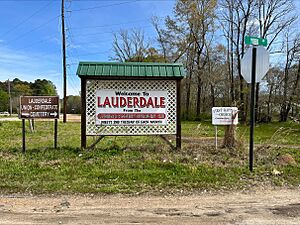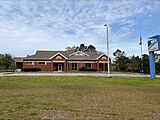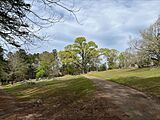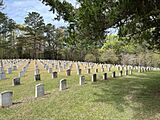Lauderdale, Mississippi facts for kids
Quick facts for kids
Lauderdale, Mississippi
|
|
|---|---|

Lauderdale welcome sign
|
|
| Country | United States |
| State | Mississippi |
| County | Lauderdale |
| Area | |
| • Total | 2.86 sq mi (7.41 km2) |
| • Land | 2.86 sq mi (7.41 km2) |
| • Water | 0.00 sq mi (0.00 km2) |
| Elevation | 215 ft (66 m) |
| Population
(2020)
|
|
| • Total | 395 |
| • Density | 138.11/sq mi (53.32/km2) |
| Time zone | UTC-6 (Central (CST)) |
| • Summer (DST) | UTC-5 (CDT) |
| ZIP code |
39335
|
| Area code(s) | 601 |
| FIPS code | 28-39600 |
| GNIS feature ID | 2586601 |
Lauderdale is a small community in Lauderdale County, Mississippi, in the United States. It's called an "unincorporated community" because it doesn't have its own local government like a city or town. It's also a "census-designated place" (CDP), which means the U.S. Census Bureau counts its population separately. In 2020, about 395 people lived there. Lauderdale is located along U.S. Highway 45, about 16 miles (26 km) northeast of Meridian.
Contents
History of Lauderdale
Early Days and Settlements
Lauderdale was first home to Native Americans. The Choctaw people had a village called Panti near where Lauderdale is today. In 1800, one of the first European settlers, James Lauderdale, arrived. He came from Tennessee and settled near some special mineral springs. He named these springs "Lauderdale Springs." James Lauderdale was a soldier who fought in the War of 1812 under Andrew Jackson. He was killed in the Battle of New Orleans.
A post office opened in the area in 1837. It was first called Mingo Houma, then Springs Depot. The community officially became a town on March 12, 1856. This happened when the Mobile and Ohio Railroad was finished nearby. A large resort was then built at the mineral springs. It had a big hotel and many small cottages. Famous people like Jefferson Davis and Octavia Walton Le Vert visited the springs for events. The post office changed its name to Lauderdale Springs in 1859.
Civil War Times
During the American Civil War, the resort at Lauderdale Springs became a hospital for Confederate soldiers. It helped wounded soldiers until the war ended. These soldiers had fought in many important battles, including Battle of Shiloh and Battle of Vicksburg. Soldiers who died from their injuries were buried in a nearby cemetery. Today, it's known as the Lauderdale Springs Confederate-Union Cemetery.
During William Tecumseh Sherman's Meridian campaign, Union soldiers burned Lauderdale Springs. Joseph Emory Davis, who was Jefferson Davis's older brother, lived in Lauderdale Springs for a while after the Siege of Vicksburg. Some military groups, like Company C of the 5th Mississippi Infantry Regiment, also gathered here.
After the War
After the Civil War, the resort grounds were used by the Mississippi Baptist Convention. They created a home there for children who had lost their parents in the war. From 1868 to 1870, soldiers from the 16th Infantry Regiment were stationed in Lauderdale. They used the old hospital buildings. In 1894, the post office name was changed to simply Lauderdale. A railway company, the East Tennessee, Virginia and Georgia Railway, stopped its service in Lauderdale in 1898.
The 1900s
By 1900, Lauderdale had grown. It had several stores, two churches, and a mill for grinding grain. About 288 people lived there. By 1936, the population had grown to 1,000 people. The community also had two cotton gins, a saw mill, and a school. There was also a lumber company and a factory that made pottery.
Geography
Lauderdale is located in the northeastern part of Lauderdale County. It sits in a valley near Possum Creek. This creek flows into Ponta Creek, which then joins the Sucarnoochee River. The Sucarnoochee River is part of the larger Tombigbee River system. The community covers an area of about 2.86 square miles (7.4 square kilometers), all of which is land.
Demographics
| Historical population | |||
|---|---|---|---|
| Census | Pop. | %± | |
| 2020 | 395 | — | |
| U.S. Decennial Census | |||
The table below shows the different groups of people living in Lauderdale as of 2020. "NH" means "Non-Hispanic."
| Race | Number | Percentage |
|---|---|---|
| White (NH) | 146 | 36.96% |
| Black or African American (NH) | 231 | 58.48% |
| Native American or Alaska Native (NH) | 1 | 0.25% |
| Asian (NH) | 1 | 0.25% |
| Some Other Race (NH) | 2 | 0.51% |
| Mixed/Multi-Racial (NH) | 10 | 2.53% |
| Hispanic or Latino | 4 | 1.01% |
| Total | 395 |
In 2020, there were 395 people living in Lauderdale. These people lived in 165 households, and 71 of these were families.
Notable People
- Lovell Harden, a former Negro league pitcher (baseball player)
- Peggy Wilson, a professional golfer who played on the LPGA Tour
Gallery
See also
 In Spanish: Lauderdale (Misisipi) para niños
In Spanish: Lauderdale (Misisipi) para niños










